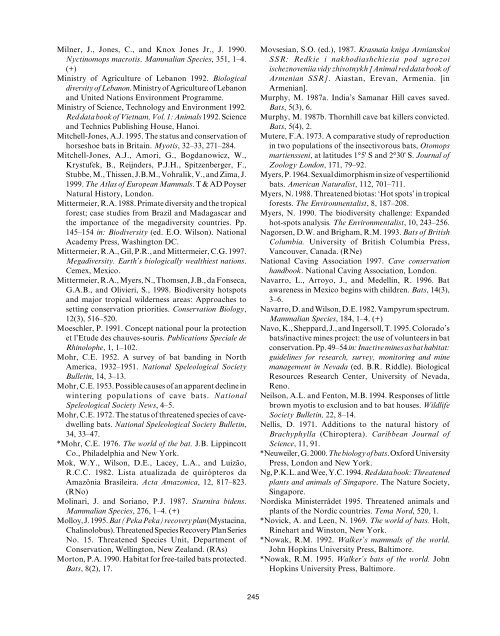Chapter 6 - IUCN
Chapter 6 - IUCN
Chapter 6 - IUCN
Create successful ePaper yourself
Turn your PDF publications into a flip-book with our unique Google optimized e-Paper software.
Milner, J., Jones, C., and Knox Jones Jr., J. 1990.<br />
Nyctinomops macrotis. Mammalian Species, 351, 1–4.<br />
(+)<br />
Ministry of Agriculture of Lebanon 1992. Biological<br />
diversity of Lebanon. Ministry of Agriculture of Lebanon<br />
and United Nations Environment Programme.<br />
Ministry of Science, Technology and Environment 1992.<br />
Red data book of Vietnam, Vol. 1: Animals 1992. Science<br />
and Technics Publishing House, Hanoi.<br />
Mitchell-Jones, A.J. 1995. The status and conservation of<br />
horseshoe bats in Britain. Myotis, 32–33, 271–284.<br />
Mitchell-Jones, A.J., Amori, G., Bogdanowicz, W.,<br />
Krystufek, B., Reijnders, P.J.H., Spitzenberger, F.,<br />
Stubbe, M., Thissen, J.B.M., Vohralik, V., and Zima, J.<br />
1999. The Atlas of European Mammals. T & AD Poyser<br />
Natural History, London.<br />
Mittermeier, R.A. 1988. Primate diversity and the tropical<br />
forest; case studies from Brazil and Madagascar and<br />
the importance of the megadiversity countries. Pp.<br />
145–154 in: Biodiversity (ed. E.O. Wilson). National<br />
Academy Press, Washington DC.<br />
Mittermeier, R.A., Gil, P.R., and Mittermeier, C.G. 1997.<br />
Megadiversity. Earth’s biologically wealthiest nations.<br />
Cemex, Mexico.<br />
Mittermeier, R.A., Myers, N., Thomsen, J.B., da Fonseca,<br />
G.A.B., and Olivieri, S., 1998. Biodiversity hotspots<br />
and major tropical wilderness areas: Approaches to<br />
setting conservation priorities. Conservation Biology,<br />
12(3), 516–520.<br />
Moeschler, P. 1991. Concept national pour la protection<br />
et l’Etude des chauves-souris. Publications Speciale de<br />
Rhinolophe, 1, 1–102.<br />
Mohr, C.E. 1952. A survey of bat banding in North<br />
America, 1932–1951. National Speleological Society<br />
Bulletin, 14, 3–13.<br />
Mohr, C.E. 1953. Possible causes of an apparent decline in<br />
wintering populations of cave bats. National<br />
Speleological Society News, 4–5.<br />
Mohr, C.E. 1972. The status of threatened species of cavedwelling<br />
bats. National Speleological Society Bulletin,<br />
34, 33–47.<br />
*Mohr, C.E. 1976. The world of the bat. J.B. Lippincott<br />
Co., Philadelphia and New York.<br />
Mok, W.Y., Wilson, D.E., Lacey, L.A., and Luizão,<br />
R.C.C. 1982. Lista atualizada de quirópteros da<br />
Amazônia Brasileira. Acta Amazonica, 12, 817–823.<br />
(RNo)<br />
Molinari, J. and Soriano, P.J. 1987. Sturnira bidens.<br />
Mammalian Species, 276, 1–4. (+)<br />
Molloy, J. 1995. Bat (Peka Peka) recovery plan (Mystacina,<br />
Chalinolobus). Threatened Species Recovery Plan Series<br />
No. 15. Threatened Species Unit, Department of<br />
Conservation, Wellington, New Zealand. (RAs)<br />
Morton, P.A. 1990. Habitat for free-tailed bats protected.<br />
Bats, 8(2), 17.<br />
245<br />
Movsesian, S.O. (ed.), 1987. Krasnaia kniga Armianskoi<br />
SSR: Redkie i nakhodiashchiesia pod ugrozoi<br />
ischeznoveniia vidy zhivotnykh [Animal red data book of<br />
Armenian SSR]. Aiastan, Erevan, Armenia. [in<br />
Armenian].<br />
Murphy, M. 1987a. India’s Samanar Hill caves saved.<br />
Bats, 5(3), 6.<br />
Murphy, M. 1987b. Thornhill cave bat killers convicted.<br />
Bats, 5(4), 2.<br />
Mutere, F.A. 1973. A comparative study of reproduction<br />
in two populations of the insectivorous bats, Otomops<br />
martiensseni, at latitudes 1°5' S and 2°30' S. Journal of<br />
Zoology London, 171, 79–92.<br />
Myers, P. 1964. Sexual dimorphism in size of vespertilionid<br />
bats. American Naturalist, 112, 701–711.<br />
Myers, N. 1988. Threatened biotas: ‘Hot spots’ in tropical<br />
forests. The Environmentalist, 8, 187–208.<br />
Myers, N. 1990. The biodiversity challenge: Expanded<br />
hot-spots analysis. The Environmentalist, 10, 243–256.<br />
Nagorsen, D.W. and Brigham, R.M. 1993. Bats of British<br />
Columbia. University of British Columbia Press,<br />
Vancouver, Canada. (RNe)<br />
National Caving Association 1997. Cave conservation<br />
handbook. National Caving Association, London.<br />
Navarro, L., Arroyo, J., and Medellín, R. 1996. Bat<br />
awareness in Mexico begins with children. Bats, 14(3),<br />
3–6.<br />
Navarro, D. and Wilson, D.E. 1982. Vampyrum spectrum.<br />
Mammalian Species, 184, 1–4. (+)<br />
Navo, K., Sheppard, J., and Ingersoll, T. 1995. Colorado’s<br />
bats/inactive mines project: the use of volunteers in bat<br />
conservation. Pp. 49–54 in: Inactive mines as bat habitat:<br />
guidelines for research, survey, monitoring and mine<br />
management in Nevada (ed. B.R. Riddle). Biological<br />
Resources Research Center, University of Nevada,<br />
Reno.<br />
Neilson, A.L. and Fenton, M.B. 1994. Responses of little<br />
brown myotis to exclusion and to bat houses. Wildlife<br />
Society Bulletin, 22, 8–14.<br />
Nellis, D. 1971. Additions to the natural history of<br />
Brachyphylla (Chiroptera). Caribbean Journal of<br />
Science, 11, 91.<br />
*Neuweiler, G. 2000. The biology of bats. Oxford University<br />
Press, London and New York.<br />
Ng, P.K.L. and Wee, Y.C. 1994. Red data book: Threatened<br />
plants and animals of Singapore. The Nature Society,<br />
Singapore.<br />
Nordiska Ministerrådet 1995. Threatened animals and<br />
plants of the Nordic countries. Tema Nord, 520, 1.<br />
*Novick, A. and Leen, N. 1969. The world of bats. Holt,<br />
Rinehart and Winston, New York.<br />
*Nowak, R.M. 1992. Walker’s mammals of the world.<br />
John Hopkins University Press, Baltimore.<br />
*Nowak, R.M. 1995. Walker’s bats of the world. John<br />
Hopkins University Press, Baltimore.












